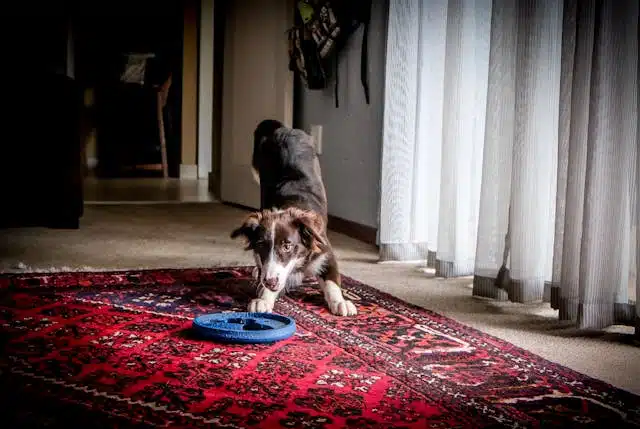Calm a Hyper Dog by understanding that hyperactivity is more than just a breed trait; Dogs that are hyper are full of unusual energy. So even if you have a dog breed that’s considered higher energy, it doesn’t mean that your dog’s hyperactivity is normal. The best way to tackle hyperactivity is to start with the dog in front of you, instead of focusing on things like breed.
In this article, we’re going to talk a little bit about why hyperactivity occurs in dogs, and why unusual energy occurs in dogs, and I’m going to give you some information about how you can help that. I know for some people out there, it’s an extremely frustrating behavior because your dog seems like they’re kind of bonkers. But in this article, you’ll have several tips to leave here with to help your hyperactive dog.
Table of Contents
ToggleReason 1: Your Pup Needs To Move Around More
The first possible reason might be that your dog just needs to move around more. If you work from home and your dog kind of sleeps around all day while you’re working, or you’re gone all day and they aren’t getting that one-on-one interaction or physical activity, they might just need more physical activity. So here’s what to do about it. Don’t just provide more physical activity. Provide more brain work with their physical activity to help calm your dog. An easy way to do this is to provide what we call mental enrichment during feeding time. Go ahead and use a puzzle toy or a puzzle feeder.

You might consider hiring a dog walker.If you’re rushed from meeting to meeting or you’ve got heavy work days, do yourself a favor and hire a dog walker. And here are a couple of things you should avoid when trying to address hyperactivity. Don’t rely on a fenced-in backyard to provide the arena basically for your dog to give themselves their own workout. Often when left to their own devices, they’re going to lay around in the grass and roll around in the sun, and they might not work out as you intended.
I’m sure a lot of you out there can relate to that feeling. Secondly, try to avoid really repetitive physical activities like fetch. Just throwing that ball over and over and over again can actually increase physical stamina and lead to more obsessive behaviors which can also lead to more problems with hyperactivity. Try to involve some brain work in between each of those throws to help calm your dog.
Reason 2: They’re Craving Attention

Another possibility might be that your dog is just craving your attention. So if you find that they’re having these short crazy bursts of energy where they’re catapulting off the couch and knocking over your morning coffee, they might actually be trying to tell you that they need more one-on-one time. Basically, you can help your dog if he’s seeking attention. Increase the quality time with your dog.
Make sure to spend time with your dog one-on-one since they are our dependents. Mark and reward calm behavior in your dog. Carry a treat pouch and throw some of your dog’s breakfast or dinner kibble into it. Add a couple of fun treats for them, and each time your dog approaches you with a nice sit instead of jumping all over you for affection, mark that behavior with a treat to let them know that you like that behavior.
Reason 3: Your Dog’s Feeling Anxious

Anxious dogs anticipate something scary might happen. So if you find that when you’re in a different environment or outside, your dog constantly breaks eye contact when you ask for it or seems hyper-vigilant like they’re watching everything or listening to everything, that could indicate anxiety. So if you have an anxious pup, here’s what you can do to help.
First things first, contact a certified dog behavior professional who can help. These folks can read your dog’s body language, determine causes and solutions, and suggest when to involve a vet or board-certified veterinary behaviorist. Use aromatherapy sprays or diffusers.
You can promote relaxation with certain scents, such as lavender and chamomile. Dogs’ ears have sensitive nerve endings. So gently rub your dog’s ears to help induce relaxation. Manage your dog’s environment and keep it out of stressful situations.
For example, if loud noises really stress them out like thunderstorms, construction, or fireworks, you want to move them out of that situation away from the house if possible into a safe, quiet place to relax. If your dog is triggered by visual cues in their environment, provide visual barriers such as frosted film on your front windows in the house so they can’t see those triggers. Give your dog calming treats. Calm Chews contain all-natural ingredients. That means just the good stuff and no fluff, so that won’t exacerbate any potential underlying conditions.
Reason 4: They’re A Little Impulsive

While it may seem on the surface that your dog is just really energetic, they might actually have underlying impulse control issues. So if your dog seems a little bit impulsive going after squirrels and such and not paying any attention to you, here’s what you can do. Practice exercises for impulse control.
Dog training builds the bond between pet parents and pets and cultivates the habit of thoughtful decision-making, which is the opposite of impulsivity. Enjoy fun and challenging dog sports for active breeds like Labrador Retrievers or Chesapeake Bay Retrievers. They enjoy activities like duck diving and field trials. Those can be excellent ways to train and burn off a lot of that excessive energy that your dog might be harboring.
Reason 5: Your Dog’s In A Stressful Environment

So if you’re experiencing personal stress at home, your dog is likely to pick up on that and feel anxious as well. As negative energy tends to compound, you might notice short bursts of hyperactivity to help them alleviate that excessive energy. If you think that your dog is experiencing stress because you are experiencing personal stress, here’s what you can do. Practice mindful breathing or box breathing to help slow your heart rate and respiration rate when you’re feeling stressed around your dog.
Pet your dog more. Research shows that this can decrease your blood pressure, decrease cortisol in the blood, and release oxytocin. Make sure you seek help for yourself as well. If you’re in a stressful home environment, consider scheduling sessions with a licensed therapist. Calming your dog requires considering them as an individual. Their emotional state is a direct reflection of their mental and their physical well-being.



